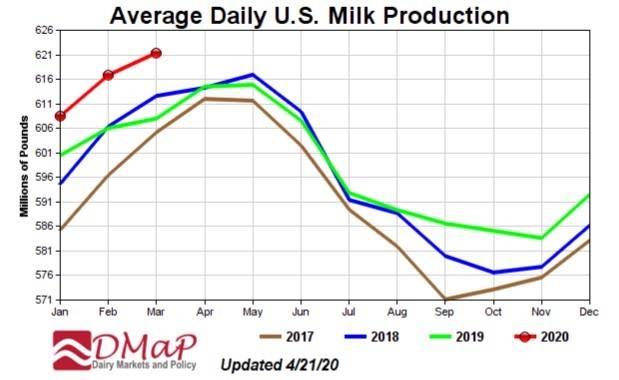Dairy Market Watch - April 2020
Katelyn Walley, Business Management Specialist and Team Leader
Southwest New York Dairy, Livestock and Field Crops Program
Struggle, Price Bottoms, and Silver Linings
By Katelyn Walley-Stoll, Cornell University Cooperative Extension
Struggle. This has been a prevailing theme, it seems to me, for April 2020. We've seen families struggling to create new routines and manage anxiety. Employees who've been laid off struggle to navigate unemployment systems, and those who have essential jobs are struggling to find child care and stay healthy. Communities struggle with balancing health and safety while also looking at potentially devastating economic downturns. I know I've struggled to put together the mountain of information that is coming in on dairy markets for this commentary in a meaningful way. But, I also know that farm owners are struggling. Farms are being bombarded with information while trying to adapt to this rapidly changing situation. Some face production restrictions, illness or employee health concerns, and dreary balance sheets. Almost all are struggling with the question of "Just how bad will this get?" while talking to lenders and family members. And I know that farmers are people, too. Hardworking people dedicated to protecting the health and safety of family, employees, animals, and their community. It's been a struggle to balance the doom and gloom with the optimism that sunshine, warmer temperatures, and spring plowing seem to bring. Yet, while we face an unprecedented decline in milk prices, there are also the little bumps in the road to deal with - a backordered part, a sick animal, or a broken stall divider.
So, just how bad will this get? We don't quite know. Some are saying that we've already hit rock bottom, others offer caution while waiting to see what export markets do, and we don't know yet how quickly the current price decline and production restrictions/limitations will shift total milk production (balancing supply and demand). In this "Average Daily U.S. Milk Production" chart, we can see the increase in milk production that happened in this year's first quarter. As Andy Novakovic, Cornell University, stated in a recent update: "On the one hand, the strong increase is not surprising in that prices were strengthening during the last half of 2019 and looking good in January and February... At this point, USDA has estimated that the increasing percentages for production reflect increasing growth rates in both yield and cow numbers, with 3/4 of the increase attributed to higher yields. This puts into perspective why cooperatives and even some non-cooperative handlers are telling their farmers to slow down". In their recent Dairy Outlook Podcast, Bob Cropp and Mark Stephenson, University of Wisconsin, discussed that we are probably close to the bottom. This is going to depend on how quickly milk production slows, when the economy opens back up, and what the export market looks like. We've already seen a $6 drop in Class III and Class IV futures since early January. There is also a concern about dairy product storages that are building, especially as global distribution chains move slowly and experience bottlenecks. But, they did comment that it looks like we could back in the $15's with some price strengthening in the second half of the year. USDA price forecasts show a $3.90 drop in Class III to $12.75, a $3.60 drop in Class IV to $12.15, and a projected all-milk price of $14.35 for 2020. Last month's forecast was $18.25.

There are some silver linings to search for through all of this. USDA's New Coronavirus Food Assistance Program did include $2.9 billion earmarked for dairy. How this will be distributed entirely, and in what amounts, still is in the air as more details continue to filter through, but some estimates show a $1-$2/cwt payment to farms. The Federal Product Purchase Program and the Nourish New York initiative will both work to move dairy into food banks and emergency food assistance streams. And through all of this, I've found hope in looking at how consumers are choosing dairy. They are stockpiling cheese, wondering how to support their local dairy farm, and stress-eating ice cream. People are thinking about where their food comes from and the farmers that grow and produce what they feed their families. Maybe this will bring about a time of continued consumer support as folks line up in the hundreds to participate in local dairy drives and share posts on social media in the thousands about supporting the industry. Hang in there and stay safe!
Dairy Market Watch - April 2020 (pdf; 2014KB)
Upcoming Events
WNY Pastureland Conversion & Soil Health Field Day
July 16, 2025
Middleport, NY
Join American Farmland Trust for the Western New York Soil Health Field Day on July 16, 2025, at Zeliff Farm in Middleport, NY, from 9:00 AM-3:15 PM. Learn about pasture conversion, soil health benchmarking, biochar in grazing systems, and best grazing practices. Plus, enjoy hands-on demos with the NY Soil Health Trailer, drones, and cover crops! Check out the attached agenda for more information about the field day and REGISTER HERE. Zeliff Farms is a regenerative beef operation who has recently partnered with AFT on outreach and education to farmers including learning circles and evaluating biochar effects on soil health.
IPM Strategies to Protect Corn and Soybean Seed in NY
July 30, 2025
Hamburg , NY
SWNYDLFC and Cornell IPM are hosting a grower meeting to discuss integrated pest management strategies for protecting corn and soybean seed in New York.
FAMACHA Training for Sheep and Goat producers in Woodhull NY
August 13, 2025 : FAMACHA Training in Woodhull
Woodhull, NY
Join us for a discussion and hands-on training for internal parasite integrated pest management in sheep and goats. Certification is available to all students participating in the workshop.
Announcements
No announcements at this time.





